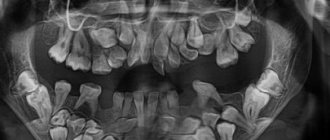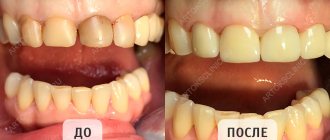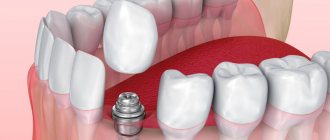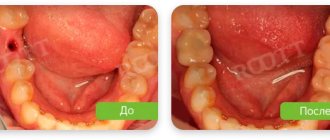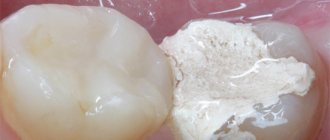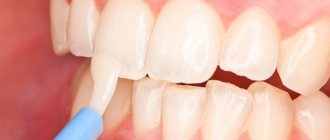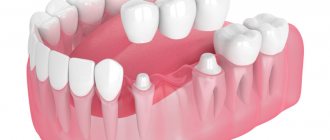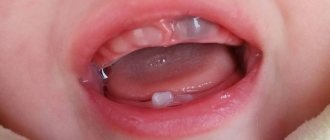A chipped tooth is one of the most common mechanical damage to the dentition; also, the breaking off of a part of a tooth can be caused by a decrease in the strength of dental tissues due to various diseases of the oral cavity. Decay of teeth, especially those located in the front part, reduces the aesthetics of a smile, so most often people try not to put off visiting the dentist. However, there are injuries that are not very noticeable at first, especially if they are not accompanied by pain, and if a tooth injury is left to chance, this can lead to unpleasant consequences.
Chipped front tooth
Dental tissue is the hardest surface in the entire body, consisting of 96% inorganic substances, 3% water and only 1% organic materials. Despite the fact that the composition of tooth enamel does not contain collagen, it contains other protein compounds, for example, enamelins and amelogenins. Dental tissue is wear-resistant and highly durable, and the top layer of enamel can reach 2.5 mm, but for all its advantages, it has a serious drawback - the inability to regenerate, so over time the tooth surface becomes thinner and there is a risk of chipping.
For modern dentistry, there is very little that is impossible, and repair of a chipped tooth can be done quickly, efficiently and effectively in our clinic, where the most highly qualified specialists and real luminaries of medicine work. And in order for our patients to be armed with information and ready for anything, we will tell you in detail about what causes a tooth fracture, what treatment methods exist and how to restore a chipped tooth.
Causes of dental chips
There are many circumstances that can lead to partial tooth destruction; among the most common, experts note the following:
- Injuries received by mechanical means, from which people who lead an active lifestyle or choose extreme sports are least insured (children jumping like saigas and teenagers fighting behind garages also fall into this category). Although, by and large, this reason is quite common, tooth damage can be caused by blows, falls, accidents, which, unfortunately, happen every day.
- Demineralization of tooth enamel, lack of calcium, fluoride and other microelements necessary to strengthen teeth are typical for women during pregnancy and lactation, and the elderly.
- Weakening of enamel due to overuse of sweet or sour foods, viscous and hard foods, exposure to high and low temperatures is at risk for those with a sweet tooth, especially those who like to drink ice cream with hot coffee.
- Carious lesions of the enamel of dental tissue, which can penetrate to the very root and significantly reduce the strength of the tooth, making it fragile and unstable even to small loads.
- An incorrect bite that disrupts the balance of stress on the dentition, which can lead to the abrasion of enamel and the appearance of areas with exposed dentin.
- Disturbed hormonal metabolism, weakened immunity, poor heredity.
- Bad habits, such as heavy smoking, the habit of cracking nuts with your teeth or opening beer bottles with your teeth like a hussar.
- Poor installation of the seal or its destruction.
Child's tooth chipped
Light filling on a pin – what are the advantages of the method?
A post filling is considered a reliable replacement material when a dentist is restoring a fractured unit. A titanium or fiberglass pin is inserted into the root canal, after which the coronal part is restored with a composite material. Among the disadvantages of the method is the potential risk of root fracture, since the pin fails under pressure, as well as shrinkage of the filling and the development of secondary caries under it.
Unfortunately, teeth restored in this way do not last forever. After 3–5 years, the dentist will have to change the filling or, due to global destruction of the crown, perform prosthetics/implantation.
Types of damage and consequences of chips
Chip of tooth enamel or microcrack
As a result, the integrity of the upper dental layer is compromised, or its particles are separated. In most cases, such damage is barely noticeable and does not cause pain to the person; experts classify these defects as mild, and people prefer not to go to the dentist with such “nonsense.” However, places where the integrity of the enamel is damaged may be subject to various stresses, which provoke the development of pathogenic microflora, carious lesions and the activity of pathogenic microorganisms.
Vertical and horizontal cracks
Chipped tooth with dentin fracture
Considered to be a moderate injury. Such damage may not be accompanied by pain, or may cause discomfort and unpleasant sensations to external stimuli: hot or cold food, sour or sweet foods. Dentin is the inner tissue of the tooth and is inferior in strength to enamel, therefore, if the lost part is not built up in time, the dentin will begin to crumble, which can lead to tooth loss. From an aesthetic point of view, even a small chip in a front tooth can significantly reduce the attractiveness of your smile.
Deep fracture of the tooth to the pulp tissue with exposure of the nerve
This type of injury is considered the most severe, often accompanied by a split tooth into two parts, profuse bleeding and sharp pain, reminiscent of the torture of the Spanish Inquisition, and even painkillers only temporarily dull the pain. In such cases, delay can be fraught with inflammation and the development of infection.
Photopolymer compositions: features and indications for installation
Such fillings for dental treatment are cured under the influence of light waves, in most cases in the ultraviolet spectrum. They are suitable for installation on the front and lateral teeth, have good adhesion to natural tissue, have a long service life, and allow you to choose a shade that is as close as possible to the color of the dentition.
Light-curing fillings are placed for:
- Protection of damaged outer (enamel) and inner (dentin) layers of the tooth.
- Restoration of medium and large cavities.
- Elimination of too wide interdental gaps.
- Correction of tooth shape.
The photopolymer composition is not recommended if the patient has severely inflamed gums, allergies to components or involuntary grinding of teeth.
What should you do first if a tooth is damaged?
Of course, if you receive slight damage to the enamel or detect microcracks, you should not escalate the situation and immediately run to the 24-hour dental care office; just make an appointment with the dentist on any convenient date. But in case of moderate or severe tooth defects, it is necessary to consult a doctor as soon as possible, having first provided first aid to yourself.
Cold compress for a damaged tooth
To do this, you need to rinse your mouth with a saline or soda solution to remove any remaining food, in case of serious damage, apply a cool compress that will prevent swelling, and in case of gum injury, use a disinfectant pad with hydrogen peroxide. If the pain is severe and there are no contraindications, a painkiller will come to the rescue. And then – straight to the doctor!
Are modern technologies used when restoring teeth?
A new product that has fundamentally improved the quality of dental restoration is 3D models of dentures. Today, a specialist carries out all the preparatory work on a computer: in a special program he creates a three-dimensional model of the prosthesis, which will subsequently be manufactured on a machine. Thanks to this, the accuracy of work has increased and, accordingly, time for fitting and fitting is saved. Prostheses that are ideal for the patient are manufactured in the clinics of the Unident network without unnecessary visits to the doctor, which distracts the patient from important matters.
Restoration of a chipped tooth: types of treatment and restoration of damage
In restorative dentistry, various methods of tooth restoration are used, depending on the type of injury, the nature of the defect, the location of the damaged tooth and the general health of the patient. In each specific clinical case, the method of tooth restoration is determined individually, but experts identify several main types of treatment for chipped teeth.
Remineralization
Remineralization is used as a method of partial restoration of tooth enamel with small defects and microcracks, for prophylaxis, to prevent the leaching of minerals and to strengthen the outer layer of the tooth. The surface is covered with a special solution containing micronutrients and enriched with minerals. Remineralization allows you to restore the protective properties of enamel.
Remineralization of tooth enamel
Fluoridation
Fluoridation is the application of medicinal preparations in the form of gels and varnishes with a high fluorine content to the damaged surface. The procedure is carried out in several stages and allows you to restore the integrity of the enamel in case of minor damage.
Building up
Extension is carried out in cases of moderate tooth trauma with partial dentin fracture; the procedure involves applying a special medical paste, fixing each layer using light radiation. When restoring in this way, a certain texture, color and shade of the building material is selected, which makes it possible to make the restored tooth practically indistinguishable from others. This technique has a relatively low cost and is effective, which has made extensions very popular.
Filling and microprosthetics
Filling and microprosthetics are used for extensive damage to dental tissue; in various cases, restoration is used using conventional fillings, stump and restoration inlays, veneers and lumineers, and in case of tooth loss, prosthetics on implants or the installation of artificial crowns are performed.
Microprosthetics of cracked teeth
For outgoing and public people, the appearance and attractiveness of a smile is often of great importance, so a chipped front tooth can become a real problem. For the restoration of teeth located in the frontal part of the dentition, onlays made of ceramics, porcelain or zirconium dioxide can be used, which are the best aesthetic solution. When using microprosthetics with veneers, you have to grind off a thin layer of enamel to make the overlay look as natural as possible; the procedure is quite unpleasant, but allows you to achieve maximum attractiveness. Lumineers are thinner, so their installation does not require grinding the enamel, but this type of lining is more vulnerable to mechanical damage. Onlays perfectly hide tooth defects and are used not only in case of chips, but also to restore aesthetic function to patients with crooked dentition and large gaps between teeth.
When restoring lateral teeth that are hidden from the eyes of others, visual appeal and beauty often fade into the background, so restoration can be performed using inlays, the main task of which is to reconstruct the integrity of the tooth and restore chewing function. Restorative inlays perform the same function as fillings, but for more extensive damage - they replenish the damaged or chipped part of the tooth, restore the original shape and relief of the dental unit. Stump inlays work on the principle of crowns - they restore the upper part of the tooth, which has preserved the root and base, but has a large affected area. Inlays are made from noble and base metals, metal alloys, which makes them wear-resistant and durable, and ceramic, metal-ceramic and light-polymer composite inlays are used to restore the color and shade of teeth. In some clinical cases, adhesive microprostheses made of fiberglass in the form of a beam can be used, which are attached to notches on adjacent teeth using medical cement; such products are hypoallergenic, light and durable.
Installation of crowns
Very often, patients are interested in whether it is possible to build up a tooth with a vertical crack and a damaged nerve, split in half to the pulp. Despite the wide arsenal of restoration methods, the most acceptable option is the removal of the injured tooth with the subsequent installation of an implant and an artificial prosthesis.
Dental implantation
A provocative question: is it possible to put a crown on the root of a tooth? Yes, if this root is an artificial implant made of titanium alloy or even zirconium. Installing an implant solves almost all problems with tooth loss:
- stops bone atrophy;
- completely restores the natural distribution of chewing load;
- no damage to neighboring teeth;
- excellent aesthetic result;
- implant service life - from 25–30 years to lifelong;
- a large number of possible options for creating crowns - ceramics, metal-ceramics, solid zirconium or zirconium with ceramic lining;
- ease of care, no different from the hygiene of natural teeth.
A child's baby tooth is chipped: do children get teeth augmented?
Children, due to their activity and curiosity, are susceptible to injuries, which can lead to the formation of chips on their teeth; in addition, in older children, the bite changes, single molars grow, which can lead to an uneven load on the milk teeth, which can lead to weakening of the enamel and the formation of cracks. Many adults mistakenly believe that such defects should not be treated, since baby teeth will fall out anyway.
If treatment for damage to baby teeth is not started in time, in addition to pain and increased sensitivity, the child may develop stomatitis, so it is necessary to visit a dentist in case of injury.
As a rule, the treatment of primary teeth occurs according to a simplified system in order to preserve temporary units before they fall out; antiseptic protective gels, fluoridation or installation of a temporary plastic filling are used to protect the tooth from further destruction.
Incorrectly restored tooth
- Poor performance of the filling , violation of technology and methodology during restoration (we will not dwell on this).
- The type of restoration is inadequately selected, in a word, “too big a filling” (i.e. they put a filling in cases where it can no longer be placed, but there are all the indications for “more serious” ceramic restorations (inlays, crowns).
I would like to dwell on the second reason in more detail.
Competent dentists know that there is an index of tooth surface destruction (DSI), which must be taken into account before restoring teeth in order to do it correctly. For you, dear patient, I will describe it in a simplified way. If the tooth is not severely damaged (conditionally up to 40% of the surface), a filling is an excellent way to restore it. Destruction of 40 to 70% of the surface requires the manufacture of a ceramic inlay or strengthening of the tooth with various pin structures.
If there is a significant degree of destruction of the tooth surface (more than 70%), the tooth should be correctly restored with a crown. In a word, the type of tooth restoration depends on the degree of destruction.
What's wrong with a filling?
Each recovery method has its own indications. So, a filling is necessary and can be placed in cases of small and medium degrees of tooth decay. If the decay is significant, a large filling can split the tooth in half.
Let's find out why!
Any material (even metal) expands when heated (remember the temperature of the tea you drink!). Temperature changes are a fairly common occurrence that our teeth encounter (from hot tea to ice cream). The coefficient of thermal expansion of filling materials is still higher than that of tooth tissue. That is, when hot food is consumed, the filling expands more than the tooth tissue that surrounds it. The larger the volume of the filling, the greater the expansion (this is why a large volume of the filling is so undesirable).
Of course, this expansion is minimal, not noticeable to any eye and not perceptible. However, add to it a chewing load (which far exceeds temperature deformations), a large filling, thinned tooth tissue, and the likelihood of chipping increases many times over.
Unlike filling materials, ceramics (from which crowns and inlays are made) have a closer coefficient of thermal expansion to the tooth tissues, and therefore do not contribute to its chipping. In addition, it is stronger. That is why it is correct to restore severely damaged teeth not with fillings, but with ceramic restorations. There are other physical phenomena that affect the change in the size of the filling and, as a result, the splitting of the tooth.
All of the above, of course, is true only with an adequately completed restoration (even fillings, even crowns). An inaccurate hand of a master can lead to chipping even with ceramic restorations, and on the contrary, a skillful hand can place a large filling so that it will last a long time. However, there is a limit to everything and it is better not to go beyond the indications for restorations if you want to get guaranteed and reliable work.
Conclusion : you should not expand the indications for conventional fillings too much; they are not capable of qualitatively restoring a badly damaged tooth. But in case of minor tooth decay, fillings have proven themselves to be excellent!
Let me give you a photographic example.
The patient complained that it was painful for her to bite on one of her teeth, that something “crunched” in it.
Upon examination, we determined: tooth 4 on the upper jaw: it has a medium-sized filling (at first glance). And a movable, broken tooth wall, which is held together only by the gums. This wall is no longer attached to the tooth.
The broken fragment of the tooth is mobile, easily moved to the side, but has not yet been removed.
View of the tooth after removing the broken wall: the cheek wall was chipped under the gum. A large filling and a thin remaining tooth wall on the palatal side are visible. Some doctors may try to restore such a tooth using a crown (with preliminary extension); some doctors will offer a perhaps more predictable option: removal and subsequent implantation.
Why are teeth restored incorrectly?
It’s absurd, but often the dentist follows the patient’s lead. The patient, not fully understanding all the subtleties and features of the distribution of the load when chewing, refuses the inlay or crown and asks the doctor to “put a filling”, they say, I’ll work with it a little more, and only then the crown! As a result, at the most inopportune moment, a “piece” of the tooth breaks off. As a result, such “pity” of the doctor for the patient turns out to be a bigger problem for the patient than timely adequate tooth restoration.
By clicking on the “Make an appointment” button, I consent to the processing of my personal data.
I have read and agree with the conditions for processing personal data set out on the website ds-chocolate.ru.
Consent to the processing of personal data
How to properly restore teeth?
When treating a tooth, the doctor must remove all carious tissues, old fillings, movable walls, if any, completely clean the tooth and only then assess the degree of destruction (which walls and cusps have survived, whether they are able to bear the load, how the load on this tooth will be distributed during different methods of restoration, whether chips of any wall are possible, whether its restoration will lead to a split of the root, etc.). After such an assessment, it is determined how to properly restore the tooth: is it possible to put a filling, or does it need to be “strengthened with a pin,” or would it be more correct to use a ceramic inlay or a crown.
Conclusion: a properly selected restoration will preserve the tooth for many years, protect it from further destruction, and the patient from having to redo the work in a few years.
What can happen if treatment is not started on time?
For some, it may seem that a chipped tooth is not such a serious defect to pay attention to it; for some people, the aesthetic component and beauty of a smile does not play a significant role, while others are willing to endure such inconveniences as increased tooth sensitivity only would not visit the dentist. However, if you ignore the problem, it can lead to more serious consequences:
- The appearance of carious lesions with damage to dentin and the formation of cavities in the tooth. In advanced cases, caries is complicated by pulpitis and periodontitis. The affected tissue not only causes severe pain, but also leads to extensive destruction, including tooth loss.
- Development of cysts and granulomas
- Displacement and shifting of the dentition due to curvature of the roots or changes in the angle of inclination of the root; the most harmless thing this can lead to is malocclusion.
The occurrence of caries at the site of tooth damage
Most of these diseases are quite difficult to treat, so you should respond promptly to emerging oral problems and not neglect medical care, so as not to become a regular client of the dentist.
Why can't we leave everything as it is?
When a person loses a tooth in the smile area, he usually tries to restore it - but with chewing teeth that are not visible, the situation is different. Many people think that if one chewing tooth is lost, then nothing bad has happened - the rest are in place, which means they can chew.
Each tooth in our jaw carries an important functional, and not just aesthetic, load. If the tooth is not restored, negative consequences will inevitably occur:
- improper distribution of the chewing load will lead to gradual destruction of the teeth next to the defect - after all, they will have to work for themselves and for the lost tooth;
- bone tissue atrophy will occur due to the fact that there is no load during chewing;
- Bite defects will appear - if a tooth has been missing for years, then its row neighbors gradually begin to shift towards the empty space;
- chewing food will not be of sufficient quality, which over the years will lead to the development of problems with the gastrointestinal tract;
- bite defects will negatively affect the functioning of the temporomandibular joint, which will provoke neck pain, headaches, discomfort and pain when opening the mouth or chewing, even insomnia;
- Diction problems will appear.
Recommendations from experts
It is impossible to completely exclude the possibility of the formation of dental defects, but in order to minimize the risk of cracks and chips in the teeth, experts recommend following a few simple rules that will help strengthen tooth enamel and make it more resistant to mechanical damage:
- Pay close attention to your oral hygiene, don’t be lazy about brushing your teeth twice a day, and don’t shy away from using dental floss and mouthwash.
- If possible, limit yourself to consuming sugary edibles. Of course, many people love cakes, sweets and ice cream, but everything should be in moderation!
- Include in your daily diet foods rich in fluoride, calcium, phosphorus and vitamin C: natural milk, sour cream, kefir, fermented baked milk, cottage cheese, various types of cheeses, herbs and nuts.
- Visiting the dentist at least twice a year, a timely scheduled examination makes it possible to identify most oral diseases at an early stage.
Types of filling materials
| Type of filling material | Short description |
| Cements | You can more accurately answer the question of how much a tooth filling costs if you know the types of cements and composites. Cement compositions are divided into:
|
| Composite | Prices for installing fillings made of composite (polymer) compositions also vary. Along the path of hardening, the latter are divided into:
|
Repairing chips on artificial teeth
Unfortunately, no one is immune from injury, so there is a possibility of damage to artificial teeth, for example, temporary metal-plastic crowns, ceramic products (in cases of high load on them) or metal-ceramic crowns. In such cases, the product can be polished, removed with subsequent repairs, or an artificial crown can be built up directly in the oral cavity using special materials - silane, opaque composition and a halogen lamp.
Polishing artificial teeth
Fillings based on cement compositions: pros and cons
| Distinctive features | Short description |
| Advantages of modern cement filling materials: |
|
| Disadvantages of compositions based on microcements: |
|
The dental clinic on Michurinsky "Diamant" in Moscow treats all forms of caries, its complications, and also eliminates damage to dentin. You can find out exactly how much a tooth filling costs only after an initial examination by a dentist. Make an appointment and come to Diamant - we will do everything to make you forget about the pain as soon as possible!
Dental restoration methods
The direct method is the application of a light-curing composite material. The doctor forms a layer, illuminates it with a UV lamp, and so on until he completely restores the shape of the tooth. A rich palette allows you to choose the shade of the composite to match the natural tone of your teeth. Finally, sanding is carried out. The restoration will last up to 5-7 years.
The indirect method is the use of veneers or crowns for chewing teeth. They are made in a dental laboratory from ceramic masses and metal or zirconium frames. Service life – 10-15 years.
Sign up for dental restoration at the Zubastik clinic
Do you want to have dental restoration done inexpensively and with high quality?
Make an appointment with a dentist by phone and come to the appointment! On the clinic’s website you can see photos of dental restoration before and after visiting a doctor, read patient reviews, see the price list for services, and choose a doctor. Our specialists will select the best option for dental treatment and restoration at a low cost. The result of turning to real professionals will be a healthy smile and self-confidence!
In what cases may tooth restoration be necessary?
It is necessary when more than half of the tooth is destroyed or when you have to seek extraction altogether.
The tooth can be destroyed as a result of being “eaten” by caries or due to other complications. Tooth loss can also occur due to mechanical trauma, which can lead to unpleasant consequences. The absence of teeth affects the health of the entire body, therefore, in case of tooth loss, it is important to consult with an orthopedist as soon as possible. What problems does missing teeth cause?
- Disruption of the digestive process. If food is poorly chewed, this can lead to malfunctions of the digestive system.
- Malocclusion. The absence of even one tooth leads to the displacement of the rest as they try to occupy the empty area
- Destruction of healthy teeth. Uneven load distribution leads to increased tooth wear and destruction
- Bone atrophy. Without chewing load, the jaw bone begins to gradually decrease in volume
To avoid all these problems, you must definitely contact the dentist to restore damaged teeth. Agree that it is better to try to solve one problem than to start it and create even more problems.
Indications and contraindications for the procedure
Main indications for tooth surface restoration:
- change in enamel shade;
- injuries (cracks, chips);
- change in shape as a result of abrasion, grinding;
- the need for recovery after caries treatment;
- curvature, presence of a gap (chapter).
Contraindications include:
- allergies to filling materials or anesthesia;
- severe forms of bruxism (night teeth grinding);
- bleeding, gum inflammation;
- presence of a pacemaker.
Dental treatment and restoration in Moscow is carried out by highly qualified specialists who will offer the best option taking into account the individual characteristics of the patient.
What is the reason?
The reason for the breakage (crumbling) of the tooth wall is simple - the tooth has been dead for a long time, the nerve has been removed, there was a large filling in the tooth, but it either crumbled or fell out. The tooth itself became fragile, and without a filling it could not withstand the stress and began to crumble, and pieces of the tooth suddenly chipped off. The remaining part of the tooth is in an even more deplorable state, the stress on it not only remains, but has increased, and the destruction of the entire tooth should be expected within a year.
Restoring a tooth by installing a filling will partially save it, but not for long. It is better to immediately address the issue of installing a crown using an inlay. A crown will reduce pressure and stress on a damaged tooth, thereby extending its “life.” The crown will stay on the tooth for an indefinite amount of time, it could be 10 years, or it could be one year; it is impossible to foresee and provide a guarantee in the case of a crumbling tooth.
